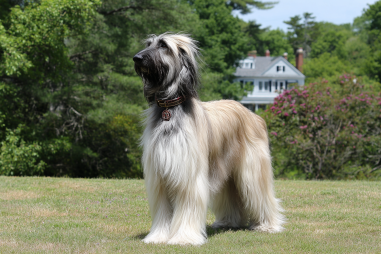Training an Afghan Hound can be a rewarding yet challenging experience. Known for their striking beauty and independent nature, Afghan Hounds are not your typical eager-to-please breed. Their aloof and sometimes stubborn personality traits can test even the most patient dog owners. However, with the right understanding of their breed-specific behaviors and effective training techniques, you can build a strong bond and achieve impressive training results with your Afghan Hound. This article explores common Afghan Hound training challenges and provides practical tips and tricks to overcome them successfully.
Understanding Breed-Specific Training Difficulties
Afghan Hounds are sighthounds originally bred for hunting in rugged terrain. They possess a high degree of independence and intelligence, which, while admirable, can make them less responsive to traditional obedience training methods. Unlike breeds that thrive on structure and approval from their owners, Afghan Hounds tend to have a mind of their own. This independence often manifests as a reluctance to follow commands, especially if they don’t see any benefit in doing so. Recognizing these breed-specific traits early on can help dog owners adjust their expectations and training techniques accordingly.
Moreover, Afghan Hounds have a sensitive nature. Harsh corrections or overly firm training methods can backfire, causing the dog to become distrustful or disengaged. Instead, they respond better to a gentle, patient approach combined with positive encouragement. Understanding these subtleties is key to developing a training routine that fits their unique temperament.
Common Behavior Issues During Training
Some common behavior challenges Afghan Hound owners may face include stubbornness, easily distracted behavior, and inconsistent responsiveness. Afghan Hounds are natural explorers, often more interested in following scents or chasing movement than paying attention to commands. This can make recall training particularly difficult, as their prey drive may override their desire to comply.
Additionally, Afghan Hounds may display aloofness or an apparent lack of motivation during training sessions. They might seem uninterested in commands or walk away from the trainer if not engaged properly. These behaviors can come across as willfulness but are often a reflection of their independent spirit and sensitivity to the training environment.
Techniques to Improve Responsiveness
To encourage better responsiveness, it’s important to keep training sessions short, fun, and highly rewarding. Afghan Hounds tend to have short attention spans, so frequent but brief training exercises work best. Mixing up commands and using a variety of rewards help maintain their interest and focus.
Incorporate the following strategies to boost responsiveness:
- Use high-value treats: Find treats that your Afghan Hound finds irresistible. This could be small pieces of chicken, cheese, or special dog treats to keep them motivated.
- Engage through play: Use toys and games as part of the training session to make learning more enjoyable.
- Train in distraction-free environments: Start training in quiet, familiar places before gradually introducing distractions as your dog improves.
- Use clear, consistent commands: Keep your cues simple and always use the same words or phrases for the same behaviors.
The Role of Consistency and Motivation
Consistency is crucial when training Afghan Hounds. Due to their independent nature, they need clear and consistent boundaries to understand what is expected. Inconsistency in commands, rules, or daily routine can confuse your dog, making training less effective.
Motivation plays a complementary role. Since Afghan Hounds are not naturally eager to please, you need to find what truly motivates your dog. This often means experimenting with different rewards such as food, toys, praise, or even short play sessions. Discovering and leveraging your Afghan’s motivators can transform training from a chore into an engaging activity.
Additionally, maintaining a calm, positive demeanor during training helps Afghan Hounds stay focused and responsive. These dogs can sense frustration or impatience, which may cause them to shut down or become resistant.
Using Positive Reinforcement Appropriately
Positive reinforcement is widely acknowledged as one of the most effective training methods for Afghan Hounds. Rewarding desired behaviors encourages your dog to repeat them, helping to build good habits over time.
When practicing positive reinforcement:
- Reward immediately after the desired behavior to create a clear association.
- Use a variety of rewards to keep things exciting and prevent boredom.
- Gradually increase the difficulty of commands while continuing to reward success.
- Avoid punishment or harsh corrections which can damage trust and reduce enthusiasm for training.
Because Afghan Hounds are sensitive, positive reinforcement not only improves behavior but also strengthens the bond between dog and owner, fostering a cooperative spirit.
Troubleshooting Stubbornness and Distractions
When faced with stubbornness or distractions, it’s important to remain patient and adapt your approach. If your Afghan Hound becomes disengaged or distracted during training, try the following tactics:
- Shorten training sessions to prevent boredom.
- Use higher-value rewards when distractions increase.
- Work on impulse control exercises such as “stay” or “wait” to improve focus.
- Remove or reduce distractions initially and slowly introduce them as your dog improves.
- Break commands into smaller steps and reward incremental progress.
It’s also helpful to note times of day when your dog is naturally more attentive or energetic to maximize the effectiveness of training.
When to Seek Professional Help
Despite your best efforts, some Afghan Hound training challenges may require professional intervention. If you’re struggling with particular behaviors like poor recall, leash pulling, or anxiety-related issues, consulting a certified dog trainer or behaviorist can be invaluable.
A professional can provide personalized guidance tailored to your dog’s temperament and your training goals. They can also teach you how to implement effective methods at home and troubleshoot stubborn issues that may not resolve with basic training.
Don’t hesitate to reach out for help if training becomes overwhelming. Early intervention often prevents minor problems from turning into major behavioral concerns.
Building a Lasting Relationship Through Training Success
Successfully training an Afghan Hound requires understanding their unique personality, patience, consistency, and the right motivation. While challenges are common, they are not insurmountable with the right approach.
By embracing positive reinforcement, keeping training sessions engaging, and adapting techniques to suit your dog’s temperament, you can foster a strong bond and promote obedience without stifling your Afghan Hound’s natural spirit. Remember, each dog learns at their own pace, and celebrating small successes along the way will keep you both encouraged.
Ultimately, training an Afghan Hound is about more than commands—it’s about building mutual respect and trust that will last a lifetime.







